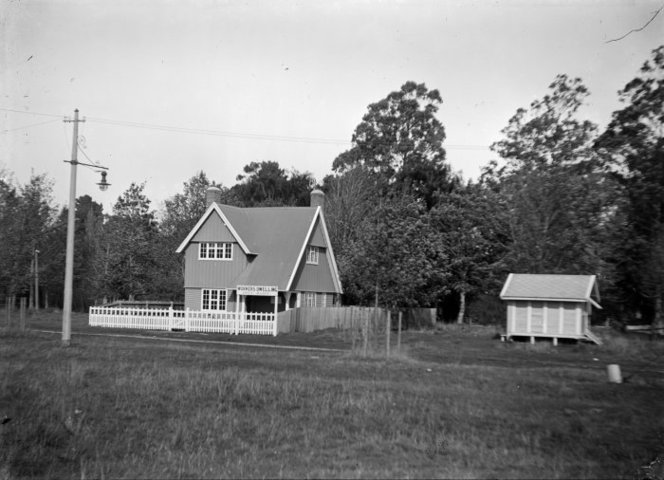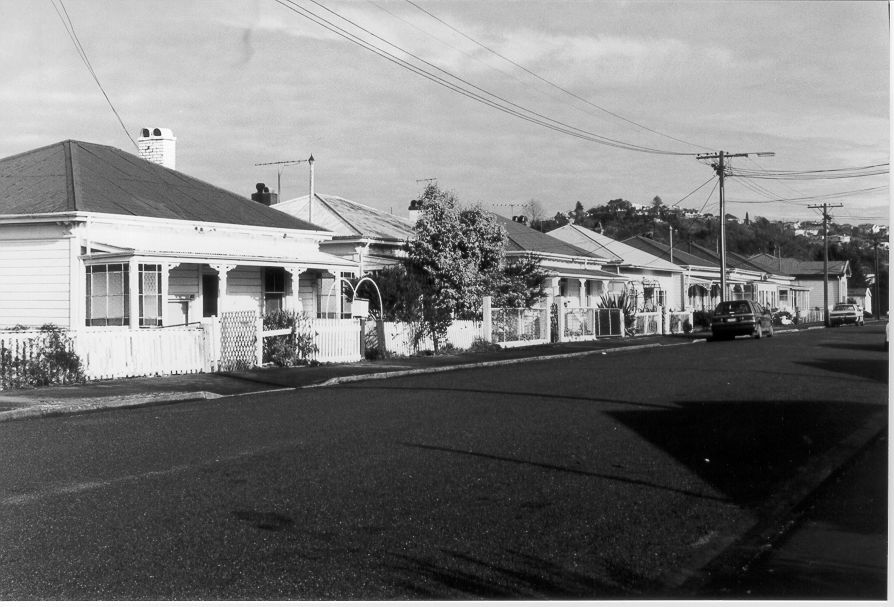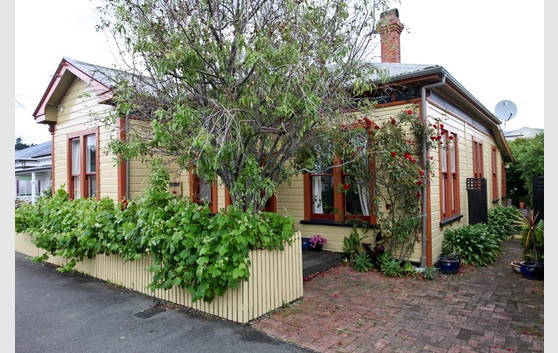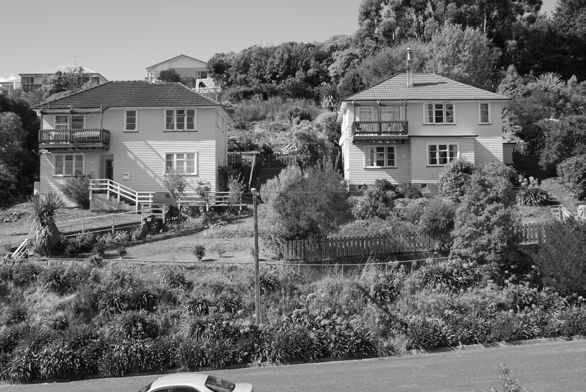Schrader, B. (2012) Housing and government. Te Ara - the Encyclopedia of New Zealand:
http://www.TeAra.govt.nz/en/housing-and-government
State housing in Nelson
State housing in New Zealand, 1905-16 In 1905 The Workers' Dwellings Act was passed to allow central government construction of houses for workers on Crown land, appropriated under the Lands for Settlements Act 1900.
State housing in New Zealand, 1905-16
In 1905 The Workers' Dwellings Act was passed to allow central government construction of houses for workers on Crown land, appropriated under the Lands for Settlements Act 1900. The Workers' Dwellings Act had been introduced by Prime Minister Richard Seddon, who was inspired by new workers' houses he had seen built by local Councils in Glasgow and London, and in response to a report in 1904, which had outlined the difficulty for workers on low incomes to buy or rent affordable housing.
The Act aimed to help workers who were defined as ”a male or female who was employed in work of any kind, or manual labour who at the time of his or her application was not in receipt of more than 156 pounds per annum and who was landless."1 A construction cost was initially set at 300 pounds, but this was modified by various amendments to the Act. Applicants had to go before a board and demonstrate both their need and moral worth.
Initially land was purchased in the four main centres. Quality control on construction meant that very similar designs were to be used. In 1906 a competition for designs was held and 150 entries submitted. Two designs were chosen for the North Island and one for the South Island.2
The South island design had less structural ornamentation and small semi-covered in entrances. All designs had five rooms; a living room, kitchen/dining room, three bedrooms (to allow segregation of different sex children) and a bathroom. An outhouse and coal shed were other conveniences provided. Houses could be wood, concrete or brick on concrete foundations and were to have subtle differences to avoid a “barracks” look.
At the International Exhibition of 1906-07 in Christchurch an exhibition house was built by Christchurch architects S.H. Seager and C. Wood and models and displays were on show for proposed state housing. The first houses were built in Petone, Wellington in 1906, where it was felt the need was highest. However few applied, as they were unaffordable for those who were targeted as possible tenants and were a considerable distance from most workplaces in Wellington city. An amendment increased the amount eligible tenants could earn.
Seddon’s dream of building 5000 workers' cottages was not realised. By 1910 only 126 had been built under the 1905 Workers' Dwelling Act and, by 1919, only 657 completed. The Act was revised in 1910, but rising building costs during the First World War and restrictions on disposal of property were problems not easily overcome when trying to provide the number of houses needed to satisfy demand.
In 1919 the original Act was replaced by a new government housing scheme.3 The Advances to Workers Act of 1906, which allowed workers to get cheap loans to build their own homes, saw 1296 taken up and the Act became the forerunner of Housing Corporation loans to first home buyers. It was thought that enabling people to build homes was a faster way to build housing stock for the country.
State Housing examples in Nelson - Elliott Street
The Winearls settlement in Elliott Street in Nelson was surveyed in 1912 for a workers' housing development of 24 lots. The Government had purchased the land for houses under the 1910 Workers' Dwelling Act. Amendments to the 1905 Act stated that houses now had to be constructed for less than 750 pounds. The proximity of the Winearls Settlement to central Nelson meant that these houses were all taken up on construction, unlike the first houses built at Petone. There is evidence of internal modifications made to at least one house to cater for a larger bedroom for a larger family.
The two-storied Park store and dwellings at 14,16 & 18 Collingwood St. all predate the establishment of Elliott St, and appear to have been built in the 1880s. Fourteen Collingwood St. is older still, and was on site in the 1860's, possiby constructed in the 1850s.
An Edwardian design was built by J. A. Stringer and Son for the first eight houses (lots 1-6, 8,9) on Eliott Street around 1913. The first two were occupied in 1914, the rest by the end of 1916. Four more lots (lots 7,8,11,16) were completed by 1918.
Building costs in both labour and materials increased at the end of World War One. This led to four houses being transported from the recently decommissioned Cable station at Cable Bay/ Rotokura as a cost saving initiative. The houses were placed on lots 14,15,18,19 and passed inspection by Council in 1921.
B. B. Jones built the houses on lots 12 and 13 using a different early bungalow style and these were occupied by 1925. Lots 20-24, together with the four adjacent sections to the west, were built in variations of the classic bungalow style. These were completed and occupied during the mid to late 1920s. Lot 17 was acquired by the Trathen family, who lived in an adjacent house, and used it as a tennis court until the land was finally built on in 1941 under wartime restrictions.
Only two of the original houses have been demolished so Elliott Street remains an excellent and unique example of a housing development originating from the 1910 Workers Dwelling' Act.4
State Housing in New Zealand, 1930s-1960s
Although something like 400 plans were adopted when the Labour Government's state housing programme was inaugurated in 1936, they were given variety by the tweaking of exterior details of a basic ‘English cottage' style. By the 1950s, state house construction had departed significantly from the pattern set by the original state houses, which were single storey, single-family homes, most in the ‘English cottage' or similar style. The introduction of two-storey single-family homes, of duplexes and then of multi-unit blocks reflected a wish to make more economical use of land, even in suburban hillside settings like Wolfe Street in Nelson.
Although double-storey state housing was mostly used for two or more joined units, variations of the double-storey, single-family houses, built in the 1950s and 1960s, can be found in state house areas throughout New Zealand. Construction of new state houses reached a new peak in the term of the second Labour Government, 1957-60. The National Government was keen on home ownership and encouraged state house tenants to buy their houses by offering favourable terms.5
State housing examples in Nelson - Wolfe Street
Five sections from a 1948 subdivision of land were taken by the Crown under proclamation 1732, in 1950, to be used for housing purposes. There were already houses built on the lower eastern side of Wolfe Street. The State houses that were constructed in 1953-55 can still be seen today at 47-57 Wolfe Street (excluding 55 Wolfe St). In 1961 the occupations of those living in the 12 state houses on Wolfe Street were typical of those who now qualified as state house tenants. They included labourer, fitter, barman, carpenter, driver, painter, butcher, presser, an announcer, teacher and a draftsman.6
These state houses, built in the early 1950s, may look very similar, but although only two designs were used twice (design no. 1307 for no. 29 and 47, and design no. 310 for no. 31 and 43) subtle variations were used to make each house a little different.7
State Housing 1970s-2012
Different ideologies between successive governments have seen a swing between a drive to increase the number of rental properties as a way to house everyone who needs it; and then a swing to have more subsidies to assist the purchase of first homes and using increased home ownership as a way of getting greater numbers of houses built, and housing stock being varied and better cared for. Increased building costs and reduction in available land to build on have created problems when trying to cover the cost of the number of houses needed.
Partnerships between Central and local government have largely been around the provision of pensioner housing. The Government has had a variety of funding methods for local community projects. Ten year interest-free loans were introduced to cover around 70% of the cost of building houses, and in 2011 the Social Housing Fund was introduced offering a contestable grant scheme using a larger pool of funding. This became the Affordable Housing Fund in 2022.
In the Nelson Tasman area there are presently around 700 Housing Corporation properties.
Nelson Tasman Housing Trust
The Nelson Tasman Housing Trust (NTHT) was formed in 2004 in response to the housing affordability crisis in Nelson. A Nelson City Council Social Wellbeing report indicated lack of affordable housing had wide implications for the economy as well as contributing to social and cultural issues. In 2004-08 it was felt that lack of affordable housing meant people were reluctant to come to Nelson to live and work meaning companies could have difficulty attracting or retaining workers.
In 2012 the NTHT owned and managed 15 houses in Nelson and Richmond. By the end of 2013 they owned 36 houses and in 2023 this had grown to 55 homes, with a view to owning 120 with the decade. Government, community and private funding was sourced. Projects are set up so that all costs, including any mortgage payments, are met from rentals over a projected period. The independent trust has been assisted with Council staff expertise, waiving of Council development fund contributions, and provision of Nelson City Council land at The Brook.
By building their own units the Trust can use universal designs that can be modified for different needs. It looks for eco-features to reduce living costs. A new project is using carpentry students from Nelson Marlborough Institute of Technology so the students can meet their training requirements and the Trust has reduced labour costs.
The Trust has a Memorandum of Understanding with 10-12 community groups around emergency housing and helps people for up to two weeks while they sort housing issues. They also have a Bond Bank where people can borrow money to pay a bond which can be a huge hurdle when trying to move into rental accommodation.8
2012 (updated 2023)
Story by: Debbie Daniell-Smith and Neil Deans
Sources
- Fill, Barbara (1984) Seddon's State Houses: the Workers' Dwellings Act 1905 and the Heretaunga Settlement. Wellington Regional Committee, New Zealand Historic Places Trust, Monograph no.1, p.6
- Fill, p.9
- Outside the mainstream - state housing in New Zealand (2012). New Zealand History Online (Ministry for Culture and Heritage):
http://www.nzhistory.net.nz/culture/we-call-it-home/outside-the-mainstream - Cadenhead, L. & Deans, N. pers comms (2012)
- Fill
- Wises Street Directory, 1960-1
- Wilson, J. (2011) Thematic historical overview of Nelson City Council. Nelson, N.Z.:Nelson City Council
- Interview Keith Preston (2012)
Further Sources
Books
- Bell, C.W.(1979) Unfinished business: the second fifty years of the Nelson City Council. Nelson, N.Z.: Nelson City Council
http://www.worldcat.org/title/unfinished-business-the-second-fifty-years-of-the-nelson-city-council/oclc/34523816 - Fill, Barbara (1984) Seddon's State Houses: the Workers' Dwellings Act 1905 and the Heretaunga Settlement. Wellington Regional Committee, New Zealand Historic Places Trust, Monograph no.1.
http://www.worldcat.org/oclc/42806912 - Firth, C, (1949) State housing in New Zealand. Wellington: Ministry of Works
http://www.worldcat.org/oclc/11780378 - Schrader, B. (2005) We call it home : a history ofstate housingin New Zealand. Auckland, N.Z. : Reed Pub
http://www.worldcat.org/oclc/62290712
Newspapers
From Papers Past:
- Eight workers' dwellings (1913, July 30) Colonist, p.4
https://paperspast.natlib.govt.nz/newspapers/TC19130730.2.34 - Workers' dwellings (1912, July 3) Colonist, p.1
https://paperspast.natlib.govt.nz/newspapers/TC19120703.2.93.10
Websites
- History of State Housing. Retrieved from December, 2012 from Housing New Zealand:
http://www.hnzc.co.nz/about-us/history-of-state-housing - Outside the mainstream - state housing in New Zealand (2012). New Zealand History Online (Ministry for Culture and Heritage):
http://www.nzhistory.net.nz/culture/we-call-it-home/outside-the-mainstream -
- State housing in New Zealand (2012) New Zealand History online (Ministry for Culture and Heritage)
http://www.nzhistory.net.nz/culture/state-housing-in-nz - Workers'dwellings (Report on), by the Hon. the Minister of Labour. Appendix to the Journals of the House of Representatives, 1911 Session I, H-11b
http://atojs.natlib.govt.nz/cgi-bin/atojs?a=d&d=AJHR1911-I.2.4.2.15
Maps
- Deans, Neil (1993, March 5) A proposed protected zone for Elliott Street in the Nelson City Council district plan. Nelson City Council.
- Elliott Street design guide (2004). Nelson City Council.
https://www.nelson.govt.nz/building-and-property/property-land-use/property-ownership/heritage-property-ownership-2/design-guides-for-heritage-precincts/ - Wilson, J. (2011) Thematic historical overview of Nelson City Council. Nelson, N.Z. : Nelson City Council
http://www.nelsoncitycouncil.co.nz/assets/About-nelson/downloads/1176312-thematic-historical-overview-of-nelson-city-OCT2011.pdf



